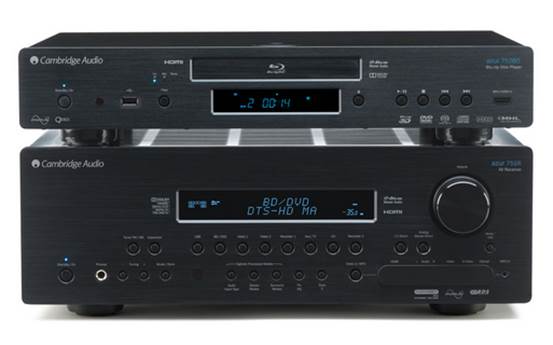Cambridge Audio’s new range-topping
AV receiver is content to leave home networking to its rivals and concentrate
solely on its AV performance.
Designed in the UK at Cambridge Audio’s
rather slick new London-based offices and Cambridge technology lab, the Azur
751R is the latest evolution of the company’s flagship AV receiver. And, far
from following the Japanese herd, the 751R is a bit, well, different.
Eccentric, even.
For starters, this must be the only AVR
currently on the market that does not have any networking features. No Wi-Fi,
no Ethernet, no internet radio, no network streaming and therefore no remote
control app. What the 751R sets out to do is be the very best-sounding AVR, for
both music and movies, for the money (a not inconsiderable $2,400). To these
ends, Cambridge Audio has gone to some serious lengths to get the 751R sounding
spectacular, including a Toroidal power supply the size of an electricity
substation, discrete amplifiers and near noiseless cooling.

The
Azur 75IR is big and heavy – but good-looking, too
Audiophile refinery doesn’t stop there
either. The chassis has been designed to reduce vibration MicroPhony and feel
uber-solid when you pick it up. Meanwhile, at the heart of the 751R you will
find a pair of top-spec Texas Instruments 32-bit processors. Unlike any other
AV receiver I can think of, the 751R up-samples all incoming audio signals to
192 kHz/24-bit before applying any DSP and outputting them to the DACs for each
channel. Upscampling has been a feature of the high-end digital hi-fi scene for
some time and can deliver a much more organic and analogue-like sound (purists
should note that with stereo inputs you can elect to bypass this processing).
Each channel is then routed to Cambridge
Audio’s discrete power amplifier modules that deliver a claimed
120W-per-channel with all channels driven. In two-channel mode the Toroidal transformer
supplies only the active channels, meaning the power output supposedly
increases to 200W-per-channel.

If you have evolved your music collection
to PC or have high-res audio files in your collection the 751R has a very neat
solution for that, too. On the back panel is an asynchronous USB input for
direct connection to your PC. While some USB DAC makers have basic
plug-and-play firmware built into the DAC, Cambridge Audio has gone a step
further and developed its own USB Class 2.0 drivers that sync with the input to
reduce jitter and improve sound quality. You will have to download these onto
your source PC, but the results, particularly using ASIO mode, more that
justify the agro. I’d argue it sets the standard for AV receivers at this price
point.
Built for purpose
If this is all starting to sound a bit too Hi-Fi,
be assured that this is definitely a home cinema receiver. Integrated decoding
for the high-res Dolby and DTS movie sound formats, the option of height
channels, an Anchor Bay 1080p video Scaler and Audyssey 2EQ are all on board.
The latter handles the auto setup routine and can be run with or without
applying any room correction. Once set, options also include Dynamic EQ and
Dynamic Volume for those who don’t always listen at 100dB SPLs. There is a
basic second-zone setup with a neat credit card-style remote supplied for the
second room – this is, of course, a seven-channel amp.

The
main handset is accompanied by a second Zone 2 remote
That is pretty much it for features, though
– a far cry from the flexibility and gadgetry of the Denons, Yamahas and Onkyos
at the same price point. The feature frugality extends to the onscreen
interface, which remains block white text menus on a blue background rather
than overlaying video on screen. A full color GUI with explanations of each
feature, it isn’t. And, given the plethora of buttons on the
Rather cluttered fascia and the familiar
sparse Cambridge Audio remote control, you will need to keep the manual close
at hand.
Setup simplicity
It’s worth running the full Audyssey EQ
setup mode as this measures your room from three different seating locations
and can smooth out bumps in your room’s acoustics. However, given the results
of the EQ in the Stevenson house, I would then nip straight back into the menus
and turn the Audyssey EQ to ‘off’.